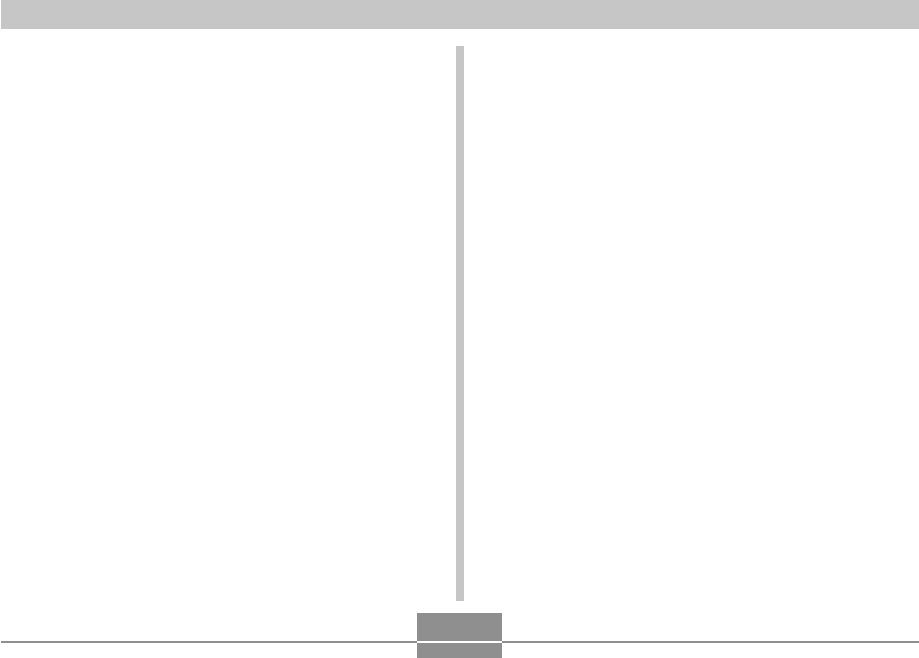User`s guide
Table Of Contents
- INTRODUCTION
- QUICK START GUIDE
- GETTING READY
- BASIC IMAGE RECORDING
- OTHER RECORDING FUNCTIONS
- Selecting the Focus Mode
- Exposure Compensation (EV Shift)
- Adjusting White Balance
- Using Continuous Shutter
- Using the BEST SHOT Mode
- Reducing the Effects of Hand or Subject Movement
- Shooting with High Sensitivity
- Recording Images of Business Cards and Documents (Business Shot)
- Restoring an Old Photograph
- Recording a Movie
- Recording Audio
- Using the Histogram
- REC Mode Camera Settings
- Assigning Functions to the [<] and [>] Keys
- Turning the On-screen Grid On and Off
- Turning Image Review On and Off
- Using Icon Help
- Specifying Power On Default Settings
- Specifying ISO Sensitivity
- Selecting the Metering Mode
- Using the Filter Function
- Specifying Outline Sharpness
- Specifying Color Saturation
- Specifying Contrast
- Date Stamping Snapshots
- Resetting the Camera
- PLAYBACK
- Basic Playback Operation
- Zooming the Display Image
- Resizing an Image
- Cropping an Image
- Keystone Correction
- Using Color Restoration to Correct the Color of an Old Photograph
- Playing and Editing a Movie
- Displaying the 9-image View
- Displaying the Calendar Screen
- Playing a Slideshow
- Rotating the Display Image
- Adding Audio to a Snapshot
- Playing Back a Voice Recording File
- Displaying Camera Images on a TV Screen
- DELETING FILES
- FILE MANAGEMENT
- OTHER SETTINGS
- Configuring Sound Settings
- Specifying an Image for the Startup Screen
- Specifying the File Name Serial Number Generation Method
- Setting the Clock
- Using World Time
- Editing the Date and Time of an Image
- Changing the Display Language
- Changing the USB Port Protocol
- Configuring [_] (REC) and [>] (PLAY) Power On/Off Functions
- Formatting Built-in Memory
- USING A MEMORY CARD
- PRINTING IMAGES
- VIEWING IMAGES ON A COMPUTER
- USING THE CAMERA WITH A COMPUTER
- APPENDIX

INTRODUCTION
11
• Color Correction (page 131)
Simply record the image of an old photograph to restore
its colors.
• MOTION PRINT (page 138)
Capture frames from a movie and create still images that
are suitable for printing.
• Calendar screen (page 140)
A simple operation displays a full-month calendar on the
camera’s monitor screen. Each day of the full-month
calendar shows a thumbnail of the first file recorded for
that date, which helps to make searching for a particular
file quicker and easier.
• Connect the camera to a TV and use the TV screen for
image recording and viewing (page 148)
• World Time (page 165)
A simple operation sets the current time for your current
location. You can select from among 162 cities in 32 time
zones.
• Support for SD memory cards and MMC (MultiMedia
Cards) for memory expansion (page 171)
• Digital Print Order Format (DPOF) (page 179)
Images can be printed easily in the sequence you want
using a DPOF compatible printer. DPOF can also be used
when specifying images and quantities for printing by
professional print services.
• PictBridge and USB DIRECT-PRINT support
(page 183)
Connect directly to a PictBridge or USB DIRECT-PRINT
compatible printer and you can print images without going
through a computer.
• PRINT Image Matching III Compatible (page 188)
Images include PRINT Image Matching
III
data (mode
setting and other camera setup information). A printer that
supports PRINT Image Matching
III
reads this data and
adjusts the printed image accordingly, so your images
come out just the way you intended when you recorded
them.
• Transfer images to a computer simply by connecting
the camera (pages 189, 196)
• DCF Data Storage (page 201)
DCF (Design rule for Camera File system) data storage
protocol provides image compatibility between the digital
camera and printers.










